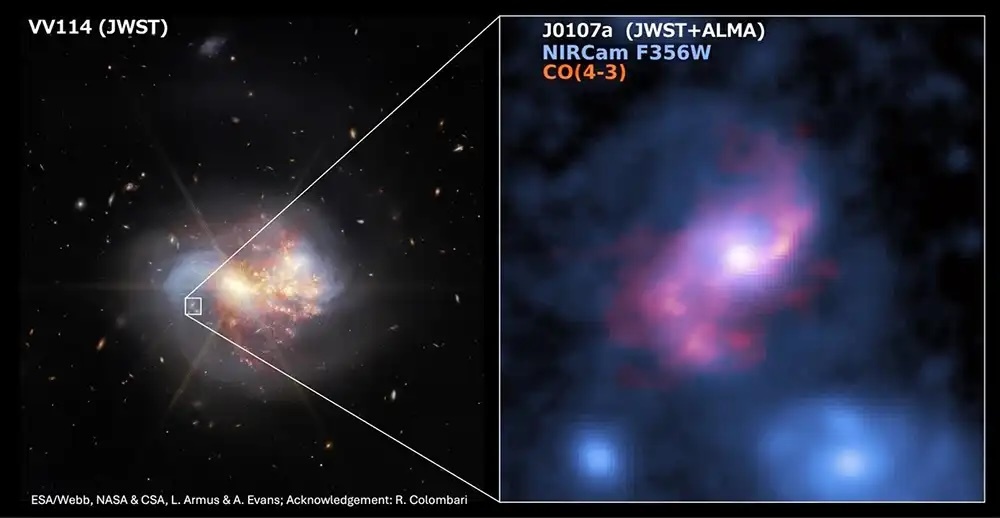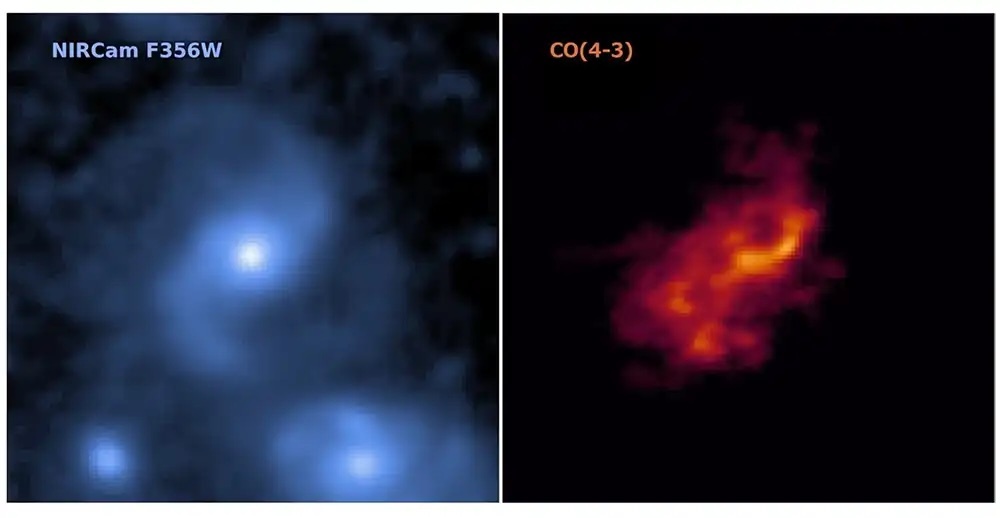25.05.2025
The discovery of a barred spiral galaxy in a universe just a couple billion years old suggests that galaxies formed and evolved much more quickly than current theories suggest.

Left: Near-infrared image of a nearby galaxy VV114 and the background monster barred spiral galaxy J0107a at z=2.467 captured by the James Webb Space Telescope (credit: NASA). Right: Stellar and molecular gas distribution of J0107a
NASA /ALMA (ESO / NAOJ / NRAO) / Huang et al
Another surprisingly advanced early galaxy adds to a growing challenge facing our notions about how — and how fast — galaxies can form.
Galaxies in the earliest epochs of the universe were once thought to be fluffy, turbulent messes of stars, with little organized structure. But then astronomers using the James Webb Space Telescope discovered spiral structure in earlier epochs than they thought they would, with spirals seen just 2 billion years after the Big Bang. Now, the next stage of galactic evolution has been spotted at similarly early times, with the discovery of a barred spiral galaxy.
Barred spirals, in which stars’ orbits naturally group them into a thick central structure, represent a step of evolution beyond spirals. A famous example is the brilliant bar of NGC 1365. “Bars are highly evolved, well-organized systems that take time to form,” writes Deanne Fisher (Swinburne University of Technology, Australia) in a perspective piece that accompanied the Nature study.
The distant barred spiral, dubbed J0107a, was actually discovered using the Atacama Large Millimeter/submillimeter Array (ALMA) in Chile, but further observations using ALMA and Webb as well as the Karl G. Jansky Very Large Array in New Mexico helped Shuo Huang (National Astronomical Observatory of Japan and Nagoya University, Japan) and colleagues examine its structures.
The new data, published in Nature, show us J0107a as it was 11.1 billion years ago, 2.6 billion years after the Big Bang (or in astronomical parlance, at a redshift of 2.467). Yet ALMA observations show that its bar appears similar to the bars we see in the Milky Way’s galactic neighbors. The presence of not just stars but gas and dust in the bar suggests that it has been around for a good while, about 1 billion years.

Left: Near-infrared image captured by the James Webb Space Telescope. The two galaxies at the bottom are the foreground objects. Right: Molecular gas distribution observed by ALMA. Gas accumulates at the leading side of the rotating bar structure and falls toward the center, just as it does in the bars of local galaxies.
NASA / ALMA (ESO / NAOJ / NRAO) / Huang et al.
Like bars in local galaxies, J0107a’s bar rearranges its host over time. The bar draws gas from the galaxy’s outer arms into its heart, shoveling more than 500 Suns’ worth of mass into the central regions every year. It’s no surprise, then, that the galaxy is experiencing a stellar baby boom. The gas inflow is 10 to 100 times more furious than in local galaxies, because there was more gas available at earlier cosmic times, Huang explains. “Local galaxies have less gas, so this effect can be only seen at high redshift,” he adds.
While J0107a is only a single example, it pushes back the starting time when bars began to form, and that in turn informs the formation process itself. “Current models posit that the gas-rich environment of galaxies in the early universe prevented the conditions that lead to bar formation,” Fisher writes. “By showing that bars do exist in early galaxies, Huang et al. directly confront this theory.”
The team proposes that the bar formed spontaneously, which means that “the bar naturally developed in a disk dominated by ordered rotation, without external disturbance,” Huang explains. The current data, for example, rule out any visible signs of a merger, which could have affected the galaxy’s evolution. It’s possible that the bar might have come into being as the galaxy itself was forming, based on estimates of both the bar’s and the galaxy’s lifetimes.
Between the capabilities of Webb and ALMA, astronomers will no doubt uncover more evolved early galaxies. Such observations will be crucial to rewriting the stories of galaxy formation and evolution.
Quelle: Sky&Telescope
